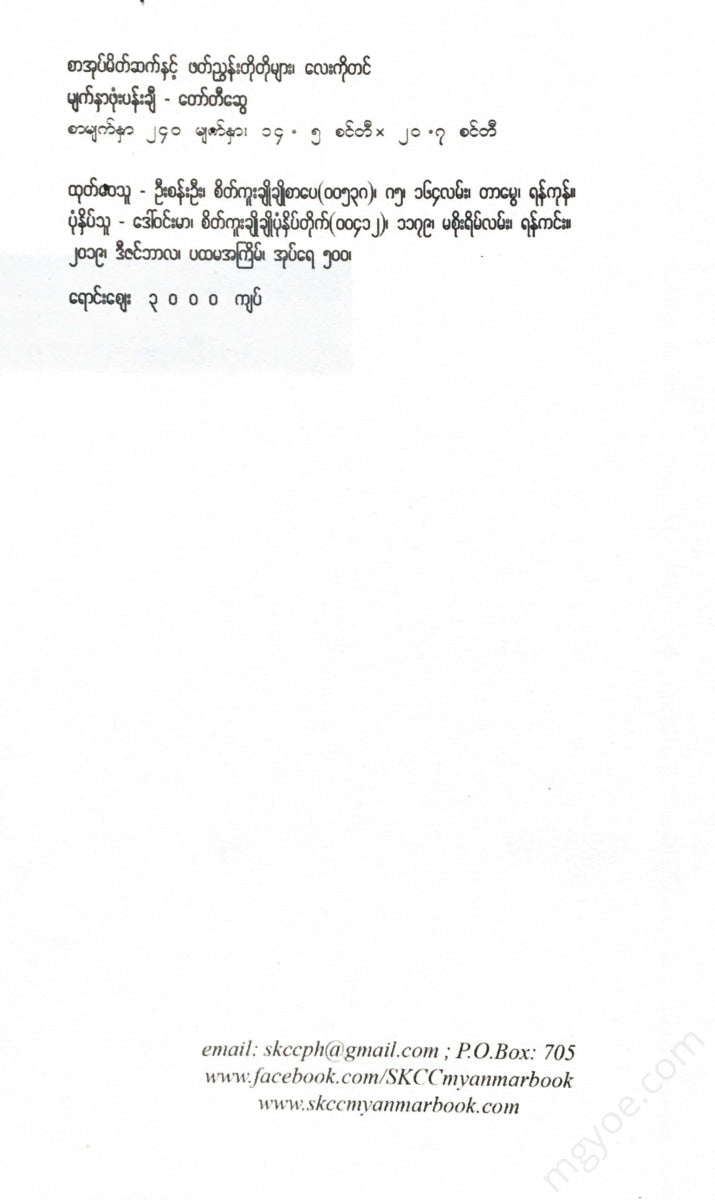စိတ်ကူးချိုချိုစာပေ
Lay Tin - Book Introduction and Short Readings
Lay Tin - Book Introduction and Short Readings
Couldn't load pickup availability
(1)
Today, the Burmese literary world is introducing magazines, book indexes, book sections, and bookshelves. Especially, the monthly published books and periodicals should be considered as introducing the readers to them. Not only in Myanmar but also in various countries.
When we first started reading in our youth (nearly 30 years ago), the first thing we noticed was the weekly book index section of Kyi Mon newspaper, ‘Gyi Maung’. From then on, we started to know which books were being published and which books to buy and read. Then there was the ‘Read Books’ section (May May Khin) from Deng Dung Magazine, ‘The World of Books’ from Ngwe Taree Magazine, etc. Around the 1970s, Moe Wai magazine published the Moe Wai Bookshelf (this section informs readers about the books that have arrived at Moe Wai Bookshelf. It is not a book review. It is just a section that describes the books). At that time, the only book was Hla Myint (Nat Nwe). Then we found and read this month’s book index (Ko O Maung), etc. Thanks to such book indexes, book shelves, and book indexes, books to read and read have come into the hands of readers.
Today, there are hundreds of books of poetry, articles (raṣa, suṭa) that come out every month. They are also very popular in terms of genre. Religion, economics, politics, society, education, health, technology, sports, science and technology, ideology, philosophy, psychology, linguistics, etc. Many of them have appeared. Among them, readers who have not noticed or missed books, read them through the book indexes of magazines, journals, and publications, and are aware of the books that should not be missed, reach their home bookshelves. Magazines are also included weekly, so the news is distributed monthly in magazines and journals, which is beneficial for the literary world. The result of that benefit is that it leads to the path of development of knowledge and dignity for the country and the nation.
(2)
The development of Burmese literature in the 20th century began with the introduction of reference books as a section of literature. For example, the Journal of the Burma Research Society (JBRS), Thuriya Ruikwo, Ganthaloka, Didok, Kyawgyi, Sane Nagani, Sasodaw, Journal Kyaw, etc. were included in the magazine. The first Burmese novel by a Burmese woman writer (Ma Aye Khin) (Chit Ro Thaw) (published in 1909) was reviewed and commented on in English by Dr. Bahan. It was included in the JBRS Journal, Volume 7, Part 2, 1917. The next Ganth
Loka Magazine also included a series of book references, first Mr. Farniball's reviews and criticisms, then Maung Wa, a scientist, and university students.
Mr. Farniball reviewed and criticized Ray Carr's (Love in Burma, Red Tiger, The Cluster of Gems) and the entire novel "The Lacquer Lady" by Tennyson Jesse. For example,
(It is a book that took my breath away and left me dumped with amazed admiration)
(That book was so powerful and captivating that it took my breath away while reading it.)
Other books and documents are also reviewed and referenced in short and concise writing under the title “Reviews.” For Maung Maung Wa, it is contemporary literature, for other writers, it is “Thein Nay Nwe” (later Thein Pe Myint)’s Min Daein, Tak Pho Gyi, Zawana’s Zawana Sa Byan, Pi Moe Ning’s short stories, etc.
From 1935 to 1940, book reviews became prominent in magazines and journals that appeared. This meant that good books were available to readers. They also began to review and comment on books under pen names. (For example, the first edition of Sasho, published in November 1935,
In the magazine "Taw" and in the journal "Yathabuta" (Maha Gyan Kyaw). Magazines and journals ceased to exist during World War II. After the war, magazines and journals reappeared. At that time, they began to refer to books published monthly as book sections. Especially in the magazine "Tara" and the magazine published by Dagon Tara. The book section was included every month. Then it was also published in journals such as "Jan Kyaw", "Lin Yone", "Naw Soh", and "Lut Hwa". Then there were "O Wai", "Shu Daung", "Shwe Tu", and other news journals.
With this past history, we can clearly see and read the life of the book index, which can be considered as a good source of information about books. The three-way relationship between the author, the reader, and the literary world is also a highlight of the benefits and growth of the country and the people.
(3)
Today is the present. Tomorrow is the future. The books that we read about today in magazines (Mahe Thi, Myanmar Dhana, Beauty Tharu Phu, Han Thit, Cherry) and journals (Market, Market, Today, News, Performing Arts) are the result of a future in which we will have to rediscover the good results of the past. Only by writing and presenting about the books that exist in the past, present, and future will the books that are called books, the friends of the people, live forever in libraries, book clubs, and the personal bookshelves of readers.
Put the bow.
New Thought Journal, 24-4-2001













